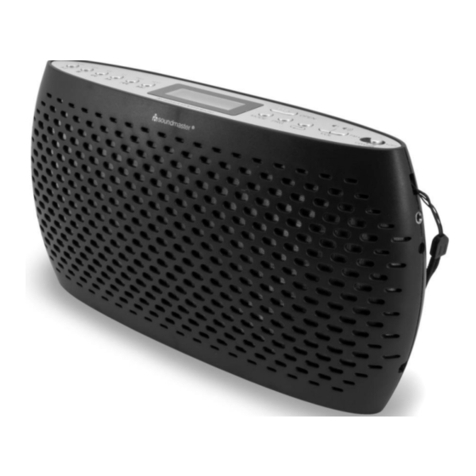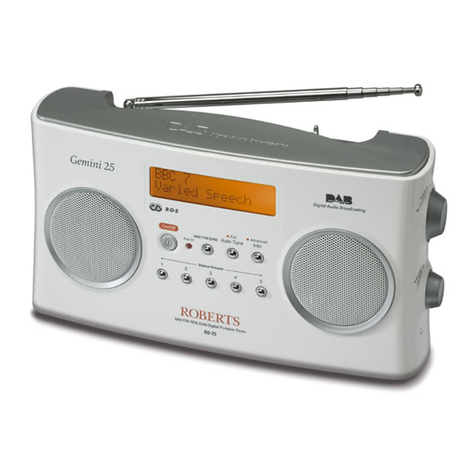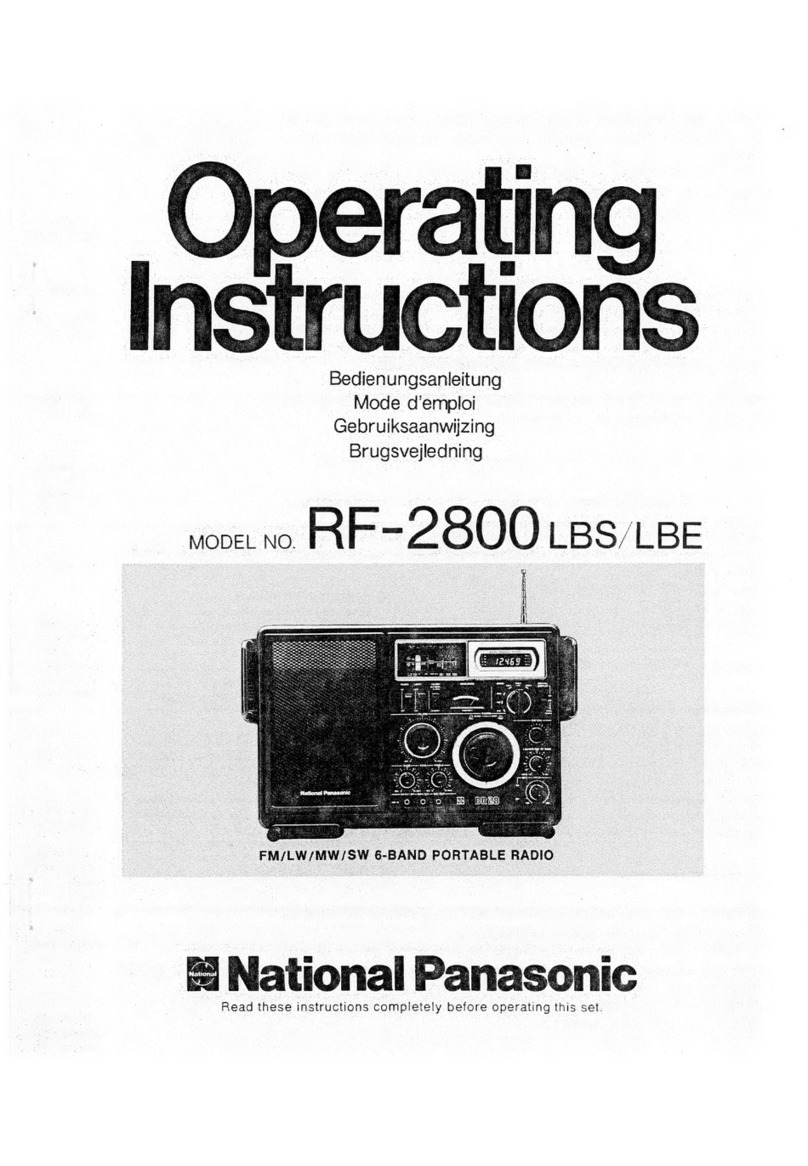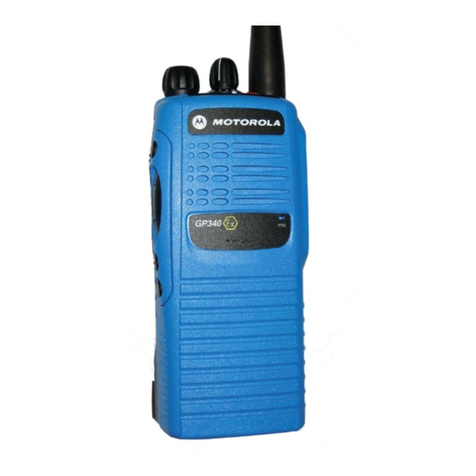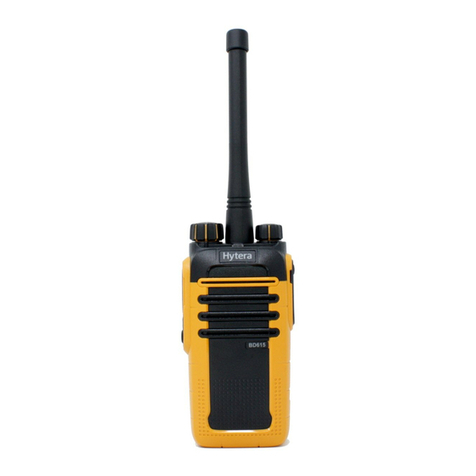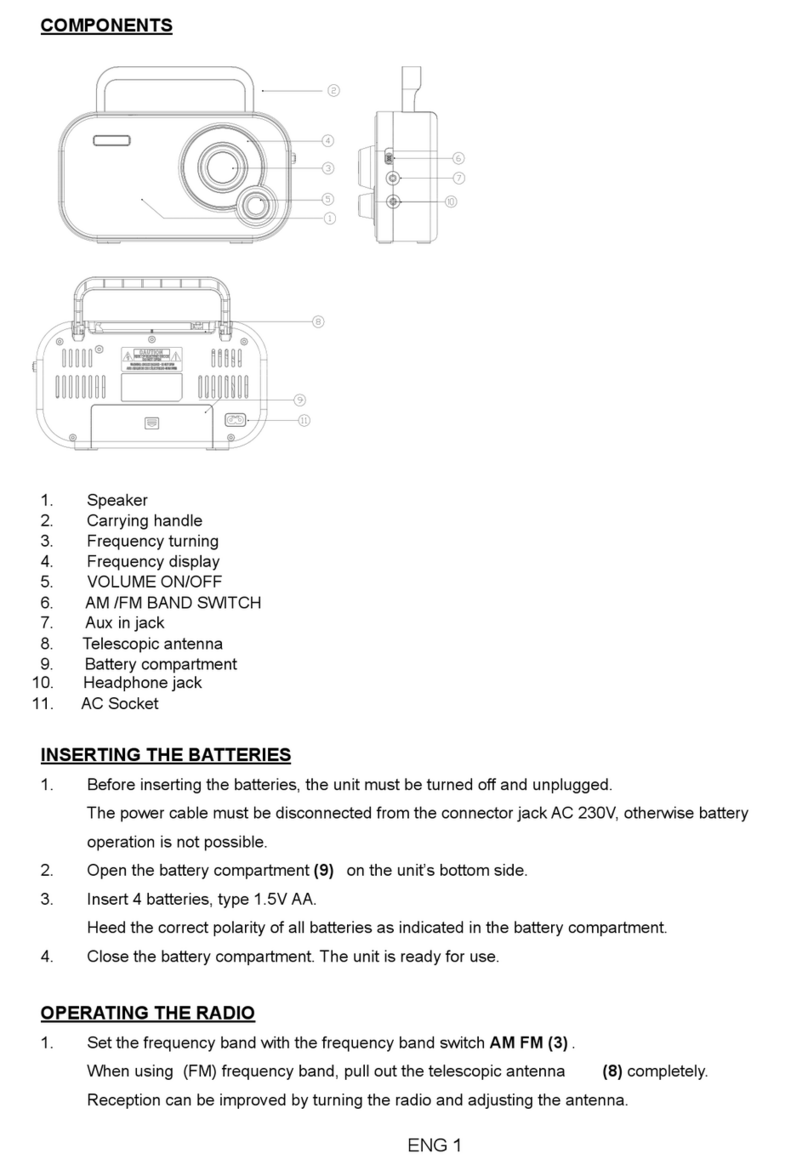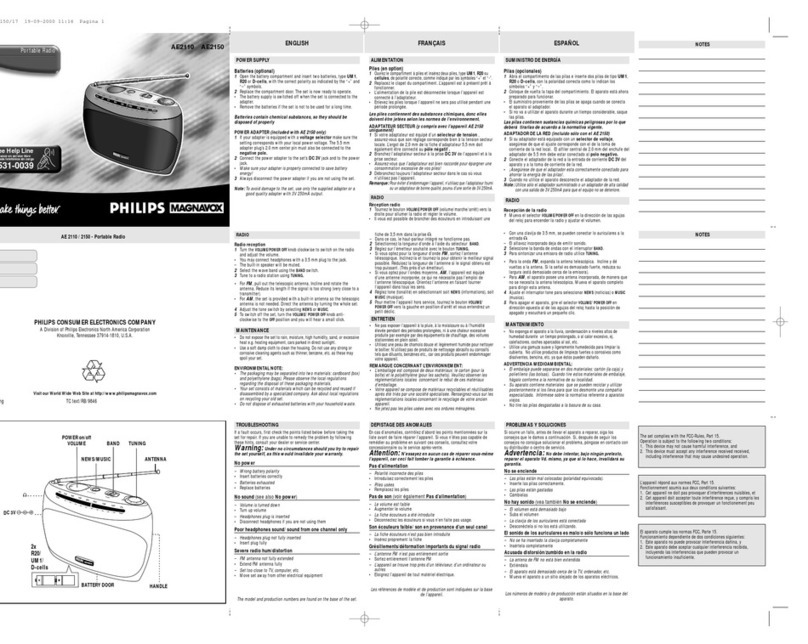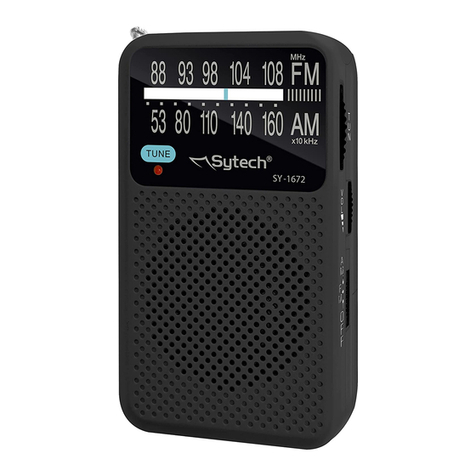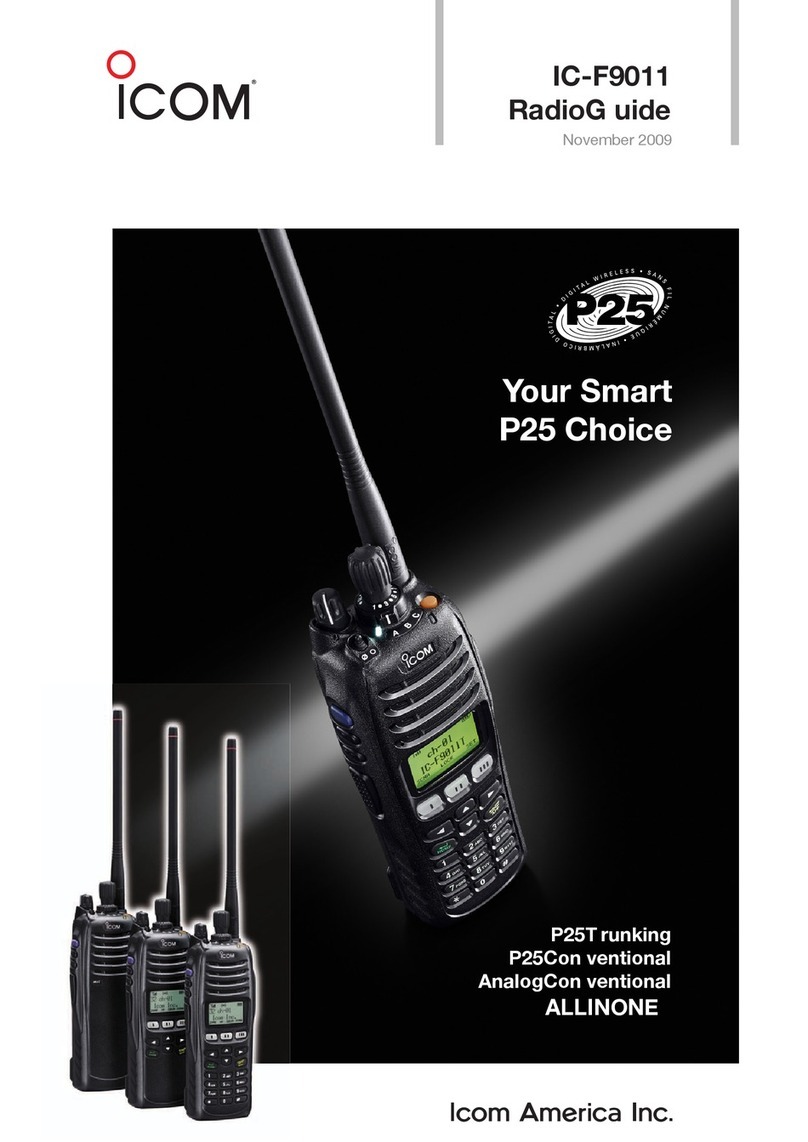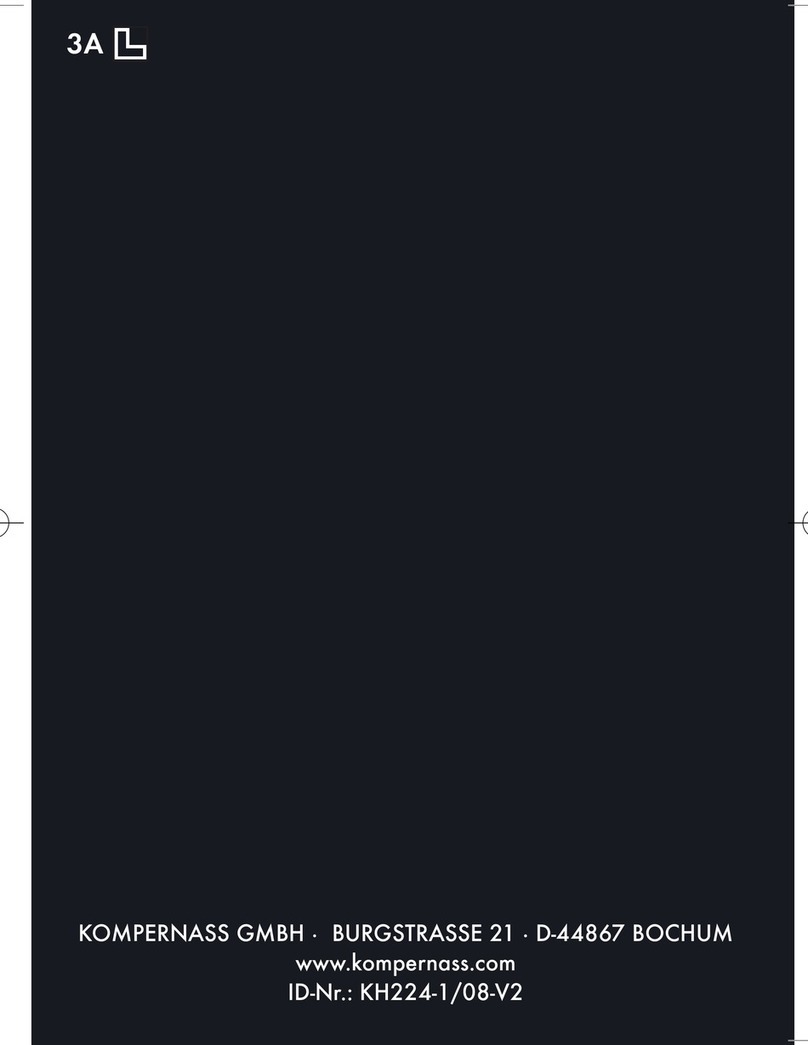Neutec SP-605H User manual

. '1::.
'"'7_~"~ ' . ~_.' ~~ ~ ~" ........~~,.....
ervice
Manual
August
~84
- - -" 11-"-'
K=
İ
_i _'.
'_'CJ' ,
P-(j05H/ P-ft02H
...Syntheşiz~d
VtiF
" 'fPortatı'e
R~~~p
/
::2CL~_'
/IIIIVEUTE
'/<.'0/
".,-?cr;n
@£joe ..- Conımurıications

ABLE OF CON EN S
,
,,:
Chapter 1
Chapter 2
Chapter 3
Chapter 4
Chapter 5
Chapter 6
Chapter 7
"Copywril~ 1987
Specifications .... __ _.... .... .... ... 1
Operation 2
heory of Operation. .. .... .... .... ...
3
Frequency Programming. .. .... .... ..
5
Alignment Procedures. .. .. ... ... ... ..
9
Parts List
1 O
Options 11
Block Diagram .- 12
Receiver Board Layout.
13
PLLI ransmitter Board Layout 14
Schematic
15
10040 Mesa Aim Ad , San Diego, CA 92121
1-800-551 8551 • 1-800-424-8491 in California
Local: (619) 587-0656 TLX: 4993540

HAPTER 1
,'~ -'I .,-~
J
pecifica tions
GENERAL
requency Ranges
Number of Channels
Programming
Supply Voltage
Current Drain (TX)
(RX)
(Standby)
TRANSMITTER
SP-605H A
SP-605H B
SP-605H C
SP-605H D
138-150 MHz
150-160 MHz
160-170 MHz
170-175 MHz
6
Synthesized
12. VDC
1100 mA
90 mA
25 mA
R Power Output
requency Stability
Duty Cycle
Spurious &Harmonics
Transmitter Rise Time
Audio requency Response (Pin 3)
RE EIVER
Sensitivity
(12 dB SINAD)
Selectivity
Modulation Acceptance
(with NB Option)
Spurious Rejection
Receiver Attack Time
requency Stability
Audio requency Response (Pin 10)
Audio Output
OPTIONS
PT-1OL Single tone encoder/decoder (CTCSS)
NB V Narrow band filter for 12.5 KHz channel spacing
/1 watt
5 PPM (-30°C to +60°C)
10%
-60 dB
40
ms
+ 1, -3 dB from a 6 dB per octave
pre-emphasis from 300-3000 Hz
.35 uV
-70 dB
:t7.5 KHz
:t2.5 KHz
-65 dB
(unsquelched)
5 PPM (,-30°C to +60°C)
+ 1, -3 dB from a 6 dB per octave
de-emphasis from 300-3000 Hz
500 mW
1

HAPTER 2
BASI OPERATING PRO EDURES
2.1 GENERAL INFORMATION
The SP-605H and SP-602H portable transeeiyers are the first
all metal, synthesized, low-eost handhelds speeifieally
designed for the professional land mobile user. These units
operate in the VHF/FM band from 136 MHz to 174 MHz. The
speeifie frequency of operation is determined by the diode-
matrix board and the eorresponding ranging erystal. By
eliminating the need of frequency crystals for each channel,
future ehannel additions are easily accommodated and the
delay time of waiting for erystals is eliminated.
Power output for the SP-605H is fiye watts in the HI position
and one watt in the LO position. The SP-602H proYides two
watts of RF output in the HI position and 0.5 watts in the LO
setting. By utilizing the LO power position wheneyer pos-
sible, the battery consumption is reduced to allow longer use
between battery charges.
Battery power for the SP-605H is proYided by a slip-on 12.0
yolt pack. The SP-602H uses a smaIler pack of the same style
with a voltage of 7.2 volts. Both of these battery paeks are
easily changed by the user. For optimum performance, these
niekel cadmium paeks should be completely diseharged
periodieally prior to recharges. This allows the battery to
take on a deeper charge whieh offers a longer use before
minimum operating voltage is reaehed.
~ ~ OPERATING PRO EDURES
2.21 ANTENNA
The helical whip (50 ohm) antenna is secured to the portable
at the BN connector. To install the antenna the eonneetors
should be mated and th~ connector turned elockwise until
locked.
2.22 VOLUME ONTROL
When the yolume control is in the full counter-clockwise
position the unit is in the OFF position. To turn the unit
ON the control should be turned clockwise until the desired
volume leve! is reaehed. To assure the proper setting, the
squelch control should be set to its full clockwise position
to allow noise to be heard from the speaker.
2.23 SQUEL H ONTROL
Once the desired yolume level is set, the squelch control
should be rotated eounter-clockwise until the background
noise just disappears. Rotation beyond this point will
elevate the squeleh threshold and weak transmissions mav be
missed. By periodically adjusting the squelch control
c::loc:kwi'c;e(referred to as "breaking squelch") the uset- can
i
:J.

arform an o erational check of the receiver and s eaker
system.
switch
engages
When
the
the
the
2.24 PTT SWITCH
To transmit from the ortable the ress-to-talk (PTT>
on the side of the unit must be ressed. This action
the transmitter and disables the receiver.
transmitting, the user should s eak across the face of
unit within a few inches of the s eaker. At the end of
transmission the PTT switch must be released to enable
receiver.
2.25 HI/LO POWER SWITCH
For extended battery life it is recommended that the radio be
o erated in the LO ower osition, whenever ossible. This
raduces the dut ut ower of the transmitter and saves battery
drain during transmissions. However, if the LO setting does
not rovide sufficient range the switch can be laced in the
HI osition. This allows maximum out ut ower from the
transmitter.
2.26 TRANSMITTER INDICATOR
When the transmitter is engaged the transmitter light will
iIIuminate to indicate transmi
er
' ower.
f the
ight fai
s
to come on during transmissions the unit should be checked by
a technician for ro er o eration.
2.27 BATTERY INDICATüR
When the battery ack is nearing a discharged condition the
battery indicator light will illuminate. When this occurs
the battery ack should be re laced or recharged.

heory of Operation
ECEIVE
Antenna Switching - eceived signal enters the antenna connector and passes through the low-pass
filler network into the F amplifier stage T 221. When theunit is in the transmit mode, the transmitted
signal is prevented from entering the F amplifier stage by the antenna switch diodes 0103 and 0104. In
the receive mode, these diodes are non-conductive and decouple the TX final stage.
F Amplifier - L201 and L202 allow inputfiltering and impedance matching to the first amplifier stage
of T 221. T 221 is a dual-gate MOSFET which provides amplification of the incoming signal.
First Mixer - After amplification, the receive signal enters the first mixer stage of T 222 where an injec-
tion signal at 21.4 MHz offset is provided. This FET helps assure minimum intermodulation interference and
maximum linearity. After mixing with the received signal, the resultant 21.4 MHz signal (with accompanying
modulation) is fed to the first IF stage of crystal filter FL201.
First IF Amplifier - FL201 reduces any incoming harmonics and provides impedance matching
to the IF amplifier stages of T 223 and T 224.
Second Mixer, Second Local Oscillator, Limiter, Detector - The circuitry centered around multi-
function IC201 constitute the second mixer stage, second local oscillator, limiter and detector. An internal
oscillator signal of 21.945 MHz is mixed with the incoming signal Qf 21.4 MHz. The resultant 455 kHz
signal is routed outboard to FL202 which reduces any harmonics and provides acıean signal for return
into IC201. Upon entering IC201, the 455 kHz signal is limited to assure stable output. This limited signal
is the n fed through a quadrature detector to strip the modulation and provide audio output from IC201.
Oiscriminator output (pin 2 of the interface connector) is obtained from pin 4 of IC201.
Squelch Circuit - Squelch threshold is established by control of an active filter within IC201. This
threshold is determined by the position of squelch potentiometer V 301. When no carrier is present, allow-
ing high frequency noise to be received, the internal filter passes this high frequency signal into rectifier
diode 0208. The resultant voltage is used to control the gating transistors of T 225-T 227. This action
reduces the power output of the audio stage IC202. When a carrier is present, the gating circuit enables
the final audio stage.
Audio Amplifier - The output from IC201 is routed through volume potentiometer V 302 to the audio
amplifier stage of IC202. The output of this stage is available through pin 4 of the interface connector or
J303.
T ANSMITTE
Transmit Audio Amplifier - Transmit audio (pin 12 of the intertace connector) is preamplified by T 205,
T 203, and T 203. The amplified audio is then fed to liffiitet T 202 iNhich prevents overmodulation. After
limiting, the audio is then routed to low-passfilter. T 201. This ,integrator circuit prevents splatter into the
transmitter.
Modulator - Audio from the speech amplifier is applied to the VCO FET, T ll0, which causes the
carrier frequency to be shifted proportionally to the audio rate. This action causes frequency modulation of
the transmitter. Audio level is controlled by deviation control V 201. Transmit data input (pin 7 of the inter-
face connector) is fed to the base of T 110 through 123.
Buffer, Multiplier, Driver, Final-Isolation for the VCO injection signal is provided by buffer T 102.
The VCO frequency at this point is half the channel frequency. The multiplier circuit of T l 03 doubles the
input frequencyand passes the transmitter signal into buffer T 104. Preamplifier T 105 amplifies the
signal to an adequate level to drive the final power amplifier T 106. During transmit mode the antenna
switch diodes 0103 and 0104 are forward biased to allow passage of the transmitter F. Also during
transmit condition, light emitting diode 0301 is forward biased to indicate transmitter operation.
3

YNTHE IZER
The primary function of the synthesizer is to provide transmitter injection signal, and local asciIIatar signal
to the receiver. This design allows a single crystal oscillator to provide stable frequency generation without
the need for tuning crystals for each channel. By dividing the reference oscillator signal by an amount
respective of the selected channel, the synthesizer can provide a range of frequencies.
Programming of the synthesizer is accomplished via the diode matrix board, located at the back of the unit.
Tlıese diodes determine the proper divide ratio for the synthesizer. (Refer to diode programming instruc-
tions in chapter 4.)
The design used in the P-605HffM is a premix PLL configuration which allows a lower frequencyoutput
from the VGü. This is desired to allow accurate division by the digital divider circuitry.
Voltage Controlled Oscillator (VCO) - The VGü consists of oscillator TR11 O and varactor diode
0106. The effective capacitance of 0106 is controlled by the OC tuning voltage. As the tuning valiage is
changed, the oscillator frequency of the VGü follows. The output of the VGü is applied to the doubler
circuits of TR101 and TR103. TR101 feeds the receiver, and TR103 provides signal into the transmitter.
The VGü output is alsa applied to cascaded buffer stages TR111 and TR112 which feed the mixer circuit
for the phased-Iocked-Ioop (PLL).
Pre-Mix Local Oscillator - In order to reduce the VGü to a frequency suitable for division by the low
speed logic, the VGü output is mixed with the output of the oscillator/doubler TR115. In the receive mode,
the VGü output must be offset from the transmit frequency by half of the first IF frequency. This, and a
semi-duplex split is accornplished by using a different crystal frequency at the pre-mix oscillator.
Mixer and Low Pass Filter - The mixer circuit of TR113 mixes the VGü frequency with the output of
the pre-mix asciIIatar TR115. The desired resultant, which is the difference frequency (or lower frequency
component) is passed by the low pass filter consisting of GH1
B,
G177, and
G17B.
Pre-Mix Local Oscillator - In order to reduce the VGü to a frequency suitable for division by the low .
speed logic, the VGü output is mixed with the output of the oscillator/-':~'lbler TR115. In the receive mode,
the VGü output must be offset from the transmit frequency by half of the first IF frequency. This, and a
serni-duplex split is accomplished by using a different crystal frequency at the pre-mix oscillator.
Oivider Buffer - The output of the low pass filter is buffered and amplified by TR114 to the level reqired
by programmable divider IG101.
Programmable Oivider - Oivision of the buffered pre-mix output is accomplished by programmable
divider IG101. The division ratio is set by the programming diodes on the diode matrix board. This division
process determines the output of the VGü. ._
Phase Comparator, Reference Oscillator/Oivider"":- By comparing the divided VGü frequency to
the reference oscillator, the synthesizer can determine if the VGü is on the proper operating frequency, as
determined by the programming diodes. If a difference is detected, the OG tuning voltage will be changed
to drive the VGü to the correct outpul.
The DG tuning voltage is derived from the fillered ou~put ofphase comparalar IC103. üutput from IG103
represents the difference between the divided output of. programmable divider IC101, and the 2.5 kHz
output from the reference oscillator/di~ider IC102,. The 2.5 kHz refere0ce signal is derived from the
10.240 Mhz reference oscillator and a fixed division ratio in the. referance divider of 4096. Any detected
difference will alter the OC tuning voltage to bring the VCü output to the correct frequency.

HAPTER 4
requency Programming
GENERAL INFORMATION
requency programming for the SP-605H is accomplished by the proper installation of diodes on the
diode-matrix board, located in the back of the uniL.Each unit is shipped with a sufficient supply of diodes
to program all six channels.
In addition to diode programming, each unit must have the proper ranging crystals installed. There are two
RX crystals (X103) and (X104), and one TX crystal (X102).
RANGING RYSTAL SELE TION
The following chart provides the proper frequency for the RX and TX crystals:
Frequency Band RX TX
(MHz) (X103
X104) (X102)
135-140 24.75 30.10
140-145 26.00 31.35
145-150 27.25 32.60
150-155 28.50 33.85
155-160 29.75 . 35.10
160-165 31.00 36.35
165-170 32.25 37.60
170-175 33.50 38.85
153-158 29.25
4.6
Note: SP-605H units are shipped from the factorywith RX1 (X103) and RX2 (X104) installed per order,
if specified. Should ranging changes be necessary, the above values should be installed according to the
desired frequency ranges. To order additional crystals, specify the desired frequency from the above charto
DIODE-MATRIX PROGRAMMING
Programming the desired frequency requires installation of diodes in the proper positions on the matrix
board (Iocated at the back of the unit). Matrix sections A through
L
correspond to the following channels:
Section A RX Channel1 Section G
=
RX Channel 1
Section B RX Channel2 Section H RX Channel2
Section C RX Channel3 Section
i
RX Channel3
Section D RX Channel4 Section
RX Channel4
Section E RX Channel 5 Section K RX Channel 5
Section RX Channel6 Section
L
RX Channel6
5

where:
RANSMII ER PROGRAMMING
iode positioning for transmitter channels can be calculated using the following formula:
N
=
(TX
.5 - ftx
2)
400
N diode programming position
TX
=
transmit frequency (MHz)
ftx
=
ranging crystal frequency (per chart 4.2 above)
Exarnple: esired transmit frequency
=
155.00 MHz
N (TX
.5 - ftx
2)
400
(155.00
.5 - 35.10
2)
400
(77.5 - 70.2) X 400
(7.3) X 400
2920
This resultant four digit number is then subjected to one of the following charts:
Chart 1 Chart 2
3000 >N>2900 3999 >N>3000
B3 2000 B3 2000
A3 .1000
2 800 2 800
C2 400 C2 400
B2 200 B2 200
A2 100 A2 100
1 80 1 80
C1 40 C1 40
B1 0 B1 20
A1 10 A1 10
O 8O 8
CO 4CO 4
BO 2BO 2
AO 1AO 1
Locations B3 - AO refer to diode locations on the diode matrix board. By installing the proper diodes.
according to the calculated number, the synthesizer provides the proper divide ratio, allowing the VCü to
operate on the proper frequency.
Example: Calculated number for N
=
2920
The binary equivalent for 2920 is determined as follows:
B3 - A3
2
2 - A2
9
1 - A1
2O - AO
O
iode programming would then then be determined as:
(B3)
( 2, A2)
(B1 )
6
Installation of the above diodes will program the transmit frequency of 155.00 MHz.

where:
ECEIVE P OG AMMING
rogramming of the receiver diodes is similar to the transmitter. The only diHerence in the procedure is the
applied formula. For receiver programming the following formula is used:
N
=
[(RX - 21.4)
X
.5 - (frx X 2)
i
400
N diode programming position
RX
=
receive frequency (MHz)
frx
=
ranging crystal frequency (per chart 4.2 above)
Example: Desired receive frequency
=
157.750 MHz
N [(RX - 21.4)
.5 - (frx X 2) X 400
[(157.750 - 21.4) X .5 - (29.75 X 2)
i
X 400
[(136.35) X .5 - (59.50») X 400
[68.175 - 59.50) X 400
8.675
X
400
3470
8y referring to the above charts, the programming diodes needed would be:
3
(83, A3)
4
(C2)
7
(C1, 81, A1)
O
Installation of diodes 83, A3, C2, C1, 81, and A1, wili program the reeeive frequency of 157.750 MHz.
ANGING C YSTAL SWITCHING
An additional diode location exists in each section of the matrix board. These locations (next to the AO
position of each section) are for the purpose of crystal switching into operationRX1 or RX2. Location A
corresponds to channel 1; 8 corresponds to ehannel 2, ete... If all locations are left empty, RX1 will be
switched into the eircuitry. Whenever a channel assignment requires the ranging of erystal RX2, a diode
should be installed into the proper loeation/ehannel assignment.
Example:
Location:
A (CH 1)
8 (CH 2)
C (CH 3)
D (CH 4)
E (CH 5)
F (CH 6)
Note: Locations G through L are unused.
Diode Installed?:
NO
NO
YES
YES
NO
YES
Crystal Used:
RX1
RX1
RX2
RX2
RX1
RX2
OIOOE INSTALLATION
The programming diodes should be earefully formed and installed with a low temperature soldering iron.
As many diodes must be housed in a smail location, care must be taken to assure that all diodes are
installed neatly and with equal spacing.
7

:::J
o
..J
o
a:
«
o
aı
a:
. ff
A - lCH RX
B - 2CH Rı(
c-:nı
RX
0- 4CH RX
E - 5Qi RX
F - OC:H RX
G -101 TX
H -
2CH
Tx
i
-:l:H TX
J -
4CH
nı
K-!:CH Tx
L - OC:H T>ı
ro

HAPTER 5
' "'~ ~~ :ı :}~
/ignment Procedures
PRELlMINARY
Alignment of the SP-605H should be performed by qualified technicians only Warranty may be void if
technical repair is attempted by anyone that is not trained and famiHar with portable communications
equipmenL
Alignment of the SP-605H can easily be accomplished with standard test equipment However, the
equipment should be within calibration standards to assure accurate alignment of the radio equipmenL
PHASE-LO KED LOOP (PLL)
Connect an oscilloscope to TP101 and adjust L118 for maximum signal (in receive mode) at this poinL
Once this is accomplished, turn the core of the coil dow n one turn to broaden the adjustmenl (This
adjustment should be accomplished on the lowest frequency that the unit is programmed to operate )
With the unit on the lowest programmed receive frequency, connect a DC voltmeter to TP103 (top of R120)
and adjust L114 for 1 28 VDC Connect a wattmeter to the antenna jack Then key the transmitter on the
lowest frequencyand increase this voltage until the transmit power appears
Connect an oscilloscope to TP104 and adjust L119 for 1 0 to 1 6 volts peak-to-peak in the transmit mode
After this adjustment, recheck the DC voltage at TP103 to assure that the voltage is less than 3 0 VDC in
the transmit mode If the reading is greater, perform the above procedure for L114 again
Canneel a frequency counter to TP105 and adjust the following variable capacitors to obtain the proper
frequency
+ /-
200 Hz) according to the following calculation:
RX
==
(Fo - 21 4)
X
5
TX
==
Fo
X
5
Where Fo
==
selected frequency
For frequencies in the lower 5 MHz receive band, adjust VC107 to obtain the proper frequency
For frequencies in the upper 5 MHz receive band, adjust VC108 to obtain the proper frequency
For frequencies in the upper 3 MHz transmit band, adjust VC106 to obtain the proper frequency
RE EIVER ALlGNMENT
Local Oscillator - Connect an RF voltmeter to the source of receiver mixer TR222 Adjust L101 and
L102 for maximum leveJ If an RF voltmeter is not available, L101 and L102 can be adjusted for best
SINAD while feeding a high level, on-channel signal to the receiver
Receiver Front-End Alignment - Input an on-channel signal into the receiver and adjust L201-L204
for best SINAD (This adjustment should be startoo on the center frequency of the programmed channels
After setting L201-L204, the outside channels should be checked for proper specifications if outside the
specified limits, readjust L201-L204 for proper readings )
IF/Detector Alignment - These circuits ~re normally factory tuned and should not be retuned unless
absolutely necessary If retuning is required, adjust L205 and L2Ö6 for best SINAD
,
'-
'
,.
"-
Squelch Threshold Adjustment -Connect"asignal generatar to the receiver and modulate the
selected frequency with a 1 kHz ane, set for 3 3 kHz deviatian Set the ouptut level of the generatar at
0.25,N.
Adjust the squelch control to maximum squelch pasition and adjust VR202 to open squelch After
adjustment, remove the input signal to the receiver and rotate the squelch control to assure that the radio is
squelched within the first quarter turn of the control
9

RANSMI ER ALlGNMEN
Preliminary - Connect a wattmeter of suitable range to the antenna connector. Adjust VC104 and
VC105 to mid-position. Check air coils
06, ll08, and
III
O,to assure that none of the coils are shorted.
ransmitter Buffer Alignment - Set the channel selector to center frequency of the programmed
frequencies. Connect a OC voltmeter to P102 and adjust Ll 03 and Ll 04 to peak vollage reading in
transmit mode. (Continue this procedure until maximum vollage is obtained. However, the cores should not
be above the top of thecans. If this occurs, resetthe cores to mid"'position and readjust.) Adjust VC10l to
maximum voltage at P102. Retrim adjustments l1 03,
LL
04, and VC10l to obtain maximum vollage.
Driver and Final Power AMP Alignment - Activate the transmitter on the radio's center frequency
and adjust VC102, VC103, VC104, and VC105, for maximum power output. If power output degrades on
outside channels, decrease VC105 (slightly) and retune VCl 02-VCl 04.
"LO" Power Setting Adjustment - Set the "lA" power switch (SW301) to the lA position and
adjust VR10l to the desired output (factory set for 1 watt).
Modulator Alignment - Set the transmitter in the "HI" position and modulate the transmitter. Adjust
VR20l for 4.8 kHz of deviation. Check the "LO" power setting to assure that the modulation remains
the same.
Power Supply Check - o assure proper operation, the SP-605HI M should not exceed the following
current drain specifications:
Model
SP-605h
SP-605H
SP-605H
Supply Voıtage
12.0 VDC
12.0 VDC
12.0 VDC
Mode
X
"Hill
X"lO"
X
Maximum Current
1.2 A
450 mA
90 mA
In the event that current drain is substantially greater than the above values, the unit should be retuned
and/or checked for defect.
HAPTER 6
"" ~'t .. ~ ., {~ '
i
'"c-' •
!.~;' :
:",i "
"
Parts List
GENERAL INFORMA ION
he schematics in Chapter 8 incorporate all component values along with the schematic identification
number. hese values, or manufacturer part numbers, should be used when replacing defactive parts.
ORDERING INFORMA ION
When ordering replacement parts from the factory,simply use the following nomenelature:
Example:
Model
SP-605H Schematic Identlficatlon
R106
10
his part number would coordinate to the final transistor ( R106) in the transmitter of a model SP-60SH/
Any changes in component values or manufacturer's part numbers will be coordinated at the factory to
assure that the proper part is replaced.

HAPTER
,
,'O ~' ,: "
ptions
INGlE TONE CTC ENCODER/DECODER (PT-10l)
Tone Data Chart
Tone Freq. Data
Tone
#
(Hz)
DO 1 2 3 4 5
1 67.0 1 11111
271.9 1 1 1 11
O
374.4
O
111 1 1
4 77.0 1 111
OO
579.7 1
O
1111
682.5
O
1111
O
785.4
OO
11 1 1
888.5
O
111
OO
991.5
1
1
O
111
10 94.8 1
O
11 1
O
11 97.4
O
1
O
1 1 1
12 100.0 1
O
11
O
O
13 103.5
O
O
111
O
14 107.2
OO
1
1
OO
15 110.9 11
O
11
O
16 114.8 11
O
1
O O
17 118.8
O
1
O
11
O
18 123.0
O
1
O
1
O O
19 127.3 1
OO
11
O
20 131.8 1
OO
1
O O
21 136.5
OOO
11
O
22 141.3
OO O
1
OO
23 146.2 11 1
O
1
O
24 151.4 11 1
OOO
25 156.7
O
1 1
O
1
O
26 162.2
O
11
OOO
27 167.9 1
O
1
O
1
O
28 173.8 1
O
1
OO O
29 179.9
OO
1
O
1
O
30 186.2
OO
1
OOO
31 192.8 1 1
OO
1
O
32 203.5 1 1
OOO O
33 210.7
O
1
OO
1
O
34 218.1
O
1
OOO O
35 225.7 1
O O O
1
O
36 233.6 1
OO O OO
37 241.8
OO O O
1
O
38 250.3
OOOO O O
witch ettings VR 701
0
OFF=
ı
do
02 04
~~~
ON=
o
c
c
01 03 05
Tone Encode Level Adjust - Key transmitter and adjust VR701 for 500 - 575 Hz CTÇ Ş t9n~ ..
devialion. (Check aıı frequencies and average accordingly.) 1

T-10L Schematic
-1011
••
..•
...
on
co
...
••
••
-
...
•••
co
... •••
••
...
co
•..
••
•• o
~TC::
w
".,0
•..
..
IO/lly
YIJOI
••
ct
•...
••
..
ol
.•.
•
•
•..
•
;,
t-
•
•
:ıl
•..
••
nu
•• o
:T~
•...m
c
715
w
ca
1702
i
O
il
w
oo
•...
o
••
Tl 7 O
i
C701
MX335
:>
~
,
•...
..
.
ca
LI>
CO
•...
...•
i
7 O 3
5.811
C 7 04
+
0.47/50V
•...
••
.•.
o
...
i~
•.•• co
...•
•...
...•
..
.•. .•.
•
•
•
•
••
•
-
•
•
4
••
J
70
i
•••
....,r.
..Ar
cl
o
Q
s
W
J
O
i
12





This manual suits for next models
1
Table of contents
